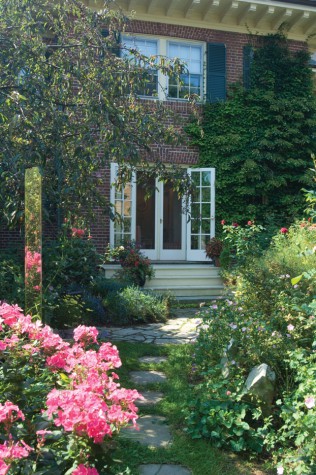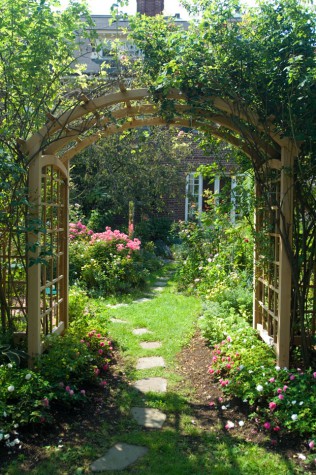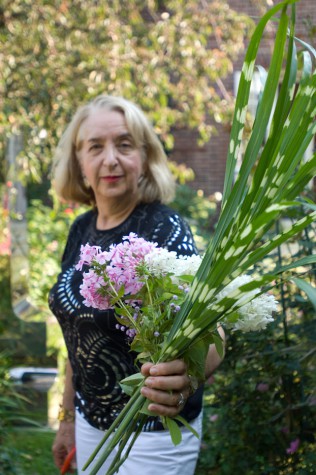Wrestling with Style
June 2009
by Debra Spark
Photography Darren Setlow
Inside the life of unexpected art dealers Rob and Annette Elowitch
If Rob and Annette Elowitch were words, they would be an oxymoron. If statements, a paradox. As it stands, they are merely unexpected: art dealers by day, a professional wrestler and his concerned (“I don’t want to see him get hurt”) wife by night. Their age—the long-married couple are in their 60s—and the prestige of their annual art auction—sales topped $4 million last year—make the contrast between their vocations all the more striking. And all the more interesting to Sports Illustrated, ABC News, and the National Enquirer, among the many news outlets that have told the couple’s story and expressed surprise that the fast-talking, gravelly voiced art broker might have, on any given day, a Sir Joshua Reynolds painting in the foyer of his home while a duffel bag packed with a black-and-gold bikini and knee-high boots waits upstairs for his next match.
The Elowitches’ careers began as whims that grew progressively more serious. High school sweethearts who were raised in Portland, Rob and Annette went away for college and a brief stint in New York before returning to Maine. At the time, Rob’s father owned a successful tire-manufacturing company, and Rob joined the business for five years before asking to be set up in his own concern. The result was Barridoff Galleries, which Rob and Annette ran as an Old Port retail space from the early 1970s to the early 1990s, when they moved the business into their West End home in order to focus on phone sales and their art auction, now held at Portland’s Holiday Inn by the Bay.
Initially the couple had, as Annette says, “book knowledge but not much else.” Still they pushed forward, aided by their friend Bill Cummings, founder of the Skowhegan School of Painting and Sculpture. “We’d go antiquing, and we’d look at things, and he’d shake his head ‘no’ or shake his head ‘yes.’” Through Bill, they met Hugh Gourley, former director of the Colby College Museum of Art, and their informal education continued.
As for the wrestling, one day while still in college Rob saw a sign that read, “Learn to Be a Professional Wrestler,” and he thought, “That’s great. That’s what I want to do.” Wrestling suited his boyhood superhero fantasies. He might not be able to fly, but he could do this.
Rob kept his avocation a secret for years. Even Annette didn’t know for the first year of their marriage, but then she kept mum, too. In 1985, the secret emerged when Rob was asked to wrestle at the Portland Expo. He hesitated, thinking his appearance wouldn’t be good for business, but Annette said, “No one’s ever going to know. No one’s ever going to care.” So he agreed. The day after the match, reports Rob, “There was a picture on the front page of the newspaper, with me essentially in my underwear, saying, ‘Does that grappler look a bit familiar?’” At the time, Rob’s sister, Linda Abromson, was Portland’s mayor.
People often say that a home expresses its owner’s personality, but in the case of Rob and Annette, that would seem a challenge. How exactly to capture their laid-back warmth, art-world savvy, and appreciation of the outrageous? Somehow their Colonial Revival home—red brick and black shuttered—manages the feat by being unassuming on the exterior and exquisitely appointed yet playful within. The home is a double house—one side is the mirror of the other—built in 1912 by architect George Burnham and his sister Amy Burnham Palmer. Burnham, alone or with his partner E. Leander Higgins, served as architect for many West End homes, as well as for several local landmarks, including Portland’s famous B&M factory. (George Burnham’s uncle—also a George—is responsible for the “B” in “B&M Baked Beans.” He started the canning business in 1867.)
It is hard to know what to look at first once inside Rob and Annette’s home. “It has, as my grandmother used to say, a lot of focal points,” says one designer who worked for the couple. Barridoff Galleries specializes in fine nineteeth- and twentieth-century American and European paintings, and so does Rob and Annette’s home. Paintings are hung throughout the house, some temporarily, others more permanently, such as the kitchen’s Joseph Nicoletti: a cool, airy still life with pomegranates. On a recent day, the dining room was dominated by two sizeable Richard Price paintings of urns, both awaiting shipment to Rob and Annette’s second home in Tuscany. The living room features more formal nineteeth-century landscapes: Venetian scenes and pastoral fantasies. “Where there’s a space, we fill it in,” says Annette. And she’s not just speaking of wall space. The ledge of her dining room mantel, the top of her bedroom dresser, and many of her side tables hold vases, plates, and bowls by Paul Heroux and Sequoia Miller, two ceramicists whose work she avidly collects.
In addition to the artwork, almost all of the home’s walls feature painted finishes by Marie Locke and Liz Moberg of South Portland’s Ralff & Sons Painted Finishes. For the front foyer, Rob and Annette requested something Italianate but were otherwise open to suggestions. Locke and Moberg looked to images of Pompeii for inspiration then painted faux-wood panels below the chair rail and a more subtle distressed finish above so as not to compete with the artwork. In the living room, they similarly divided the walls with painted trompe l’oeil red panels below and a yellow-beige paint with red flecks above. Portland artist Toni Wolf painted the living room’s corners with scenes of the Tuscan hillside as they might look if viewed through columns. Cherubs float above. “The room,” Annette says of the couple’s decision to incorporate the putti, “was looking too serious.” Locke and Moberg painted in a number of other rooms in the home, including a crackle finish for the cupboards of the recently renovated kitchen, and fanciful leaves and shamrocks that suggest, in one third-floor bedroom, Matisse’s cutouts and, in another, the forms of a Calder mobile.
Rob and Annette’s approach to home decorating seems to be this: if you pick talented people, they will know what to do. And the designers appreciate getting free rein to create what they think will work best in the home. Joseph Ferigno of J. Ferigno Designs, who is responsible for much of the home’s drapery and upholstery, says that Annette works with designers the way you would work with an artist: “You would never,” he explains, “tell a painter what to paint.”
Not forefronted in the house, but by no means hidden, is a back staircase whose yellow-striped walls are lined with framed photographs and newspaper clips, all focusing on Rob, or “Robbie Ellis,” as he is known in the ring. There’s Rob in a headlock, Rob being flipped over the back of some hulking figure, Rob vamping in his black-and-gold bikini or wearing, on a different occasion, white leather boots and red trunks. The “Hall of Fame” gallery may well continue to grow up the staircase walls. Rob’s physique—he’s slim and a mere 5’7”—didn’t stop him from wrestling years ago, and his age isn’t stopping him now. In the trailer to Gary Robinov’s Canvasman, an upcoming documentary about Rob, the Portland wrestler and art dealer says, “At this point in my life, I get asked one time much too many, ‘How old are you?’ and I know what is coming: ‘Gee! You look great for a guy your age.’ I want to respond, ‘[Expletive] you, I look great for a guy your age.’”
While self-mocking is part of Robbie Ellis’s persona and his home’s back stairwell, Annette and Rob are seriously fond of the house in which they have lived for thirty-six years. “I love this house desperately,” Annette says. “It’s me. All good things and bad things happened here.”










